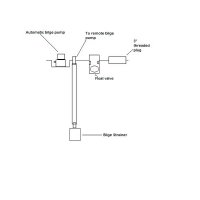Heavy winds in Northern Michigan caused our beloved South Wind to pull the cleats off the bow (mooring points) and run aground .
.
Once pulled off the shore she was taking in water, about 4 gallons per minute.
She was towed to safe harbour with a 2" gas pump keeping her dry.
She was immediatly pulled on to her cradle. The keel looked good except for the lower part where there was damage and sections missing. I was told that some of the keel may be hollow causing the leakagr through the bottom of the keel into the boat. Does anyone have information to verifiy this. It seems strange that damaging the bottom of the keel will cause leakage that extensive.
Any comments would be appreciated!
B. Paul
Once pulled off the shore she was taking in water, about 4 gallons per minute.
She was towed to safe harbour with a 2" gas pump keeping her dry.
She was immediatly pulled on to her cradle. The keel looked good except for the lower part where there was damage and sections missing. I was told that some of the keel may be hollow causing the leakagr through the bottom of the keel into the boat. Does anyone have information to verifiy this. It seems strange that damaging the bottom of the keel will cause leakage that extensive.
Any comments would be appreciated!
B. Paul

